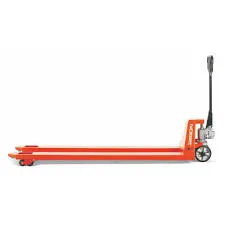


The Importance of Hand Fork Trucks in Modern Warehousing
In the realm of logistics and warehousing, efficiency is the cornerstone of success. Among the various equipment used to streamline operations, hand fork trucks, often known as pallet jacks, play a pivotal role. These simple yet effective tools are essential for the effective movement and storage of goods, especially in environments that require flexibility and agility.
Hand fork trucks are manually operated devices designed for lifting and transporting pallets. Unlike their motorized counterparts, hand fork trucks are much more economical and require no fuel or battery charging, making them an excellent choice for small and medium-sized businesses. Their design typically consists of two forks that slide underneath a pallet, which can then be lifted and moved with ease.
One of the primary advantages of using hand fork trucks is their versatility. They can maneuver in tight spaces that larger forklifts cannot navigate. This makes them particularly useful in crowded warehouses or stores where aisle space is limited. Operators can easily transport goods between shelves and loading areas, increasing the efficiency of inventory management.
Moreover, hand fork trucks are incredibly user-friendly
. With minimal training, staff can quickly learn to operate them safely and effectively. This accessibility promotes a more flexible workforce, as employees can shift roles without extensive retraining. In addition, hand fork trucks require lower maintenance compared to powered lift equipment, contributing to cost savings in the long run.Safety is a critical concern in any warehouse setting. While hand fork trucks are generally safe to use, operators must still be aware of best practices to prevent accidents. For instance, maintaining a clear line of sight while moving loads, not overloading the pallet, and ensuring that the load is stable can significantly reduce the risk of mishaps. Furthermore, wearing appropriate safety gear, such as steel-toed boots, can protect operators from potential injuries.

Integrating hand fork trucks into the daily operations of a warehouse can lead to noticeable improvements in productivity. By facilitating the efficient movement of goods, these trucks help reduce the amount of time spent transporting items, allowing staff to focus on other important tasks. Additionally, using hand fork trucks minimizes the wear and tear on the floor, as they are less likely to damage surfaces compared to larger forklifts.
The economic implications of employing hand fork trucks are also noteworthy. Their low upfront cost and reduced operational expenses make them attractive investments for businesses looking to optimize their warehousing capabilities. This financial advantage allows companies to allocate resources to other areas of their operations, fueling growth and innovation.
In the evolving landscape of logistics and supply chain management, adaptability is key. Hand fork trucks offer a flexible solution that can respond to fluctuating demands. They can be easily stored and retrieved as needed, allowing warehouses to expand or contract their operations without significant additional investments. This flexibility is particularly advantageous during peak seasons or promotional events when demand for products surges.
Moreover, with the increasing push towards sustainability, hand fork trucks align well with green practices. Their manual operation eliminates emissions associated with powered equipment, contributing to a more eco-friendly work environment. Businesses that prioritize sustainable practices can leverage hand fork trucks as part of their commitment to reducing their carbon footprint.
In conclusion, hand fork trucks are indispensable tools in modern warehousing. Their cost-effectiveness, user-friendliness, and versatility make them ideal for a range of applications. As businesses continue to seek ways to enhance productivity and efficiency, hand fork trucks will undoubtedly remain a cornerstone of warehouse operations, supporting seamless logistics and fostering growth in the industry. By embracing this simple yet powerful equipment, companies can navigate the complexities of modern supply chains with ease and confidence.



